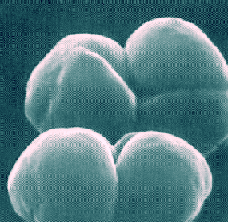Methanosarcinales
In taxonomy, the Methanosarcinales are an order of the Methanomicrobia.[1]
| Methanosarcinales | |
|---|---|
 | |
| Methanosarcina barkeri fusaro | |
| Scientific classification | |
| Domain: | Archaea |
| Kingdom: | Euryarchaeota |
| Class: | Methanomicrobia |
| Order: | Methanosarcinales Boone et al. 2002 |
| Families | |
| Synonyms | |
| |
Large amounts of methane are produced in marine sediments[2] but are then consumed before contacting aerobic waters or the atmosphere. Although no organism that can consume methane anaerobically has ever been isolated, biogeochemical evidence indicates that the overall process involves a transfer of electrons from methane to sulphate and is probably mediated by several organisms, including a methanogen (operating in reverse) and a sulfate-reducer (using an unknown intermediate substrate).
Organisms placed within the order can be found in freshwater, saltwater, salt-rich sediments, laboratory digestors, and animal digestive systems. Most cells have cell walls that lack peptidoglycan and pseudomurein. They are strictly anaerobic and survive by producing methane. Some species use acetate as a substrate and others use methyl compounds, such as methyl amines and methyl sulfates.[3]
Phylogeny
| 16S rRNA-based LTP_01_2022[4][5][6] | 53 marker proteins based GTDB 07-RS207[7][8][9] | ||||||||||||||||||||||||||||||||||||||||||||||||||||||
|---|---|---|---|---|---|---|---|---|---|---|---|---|---|---|---|---|---|---|---|---|---|---|---|---|---|---|---|---|---|---|---|---|---|---|---|---|---|---|---|---|---|---|---|---|---|---|---|---|---|---|---|---|---|---|---|
|
|
See also
References
- See the NCBI webpage on Methanosarcinales. Data extracted from the "NCBI taxonomy resources". National Center for Biotechnology Information. Retrieved 2007-03-19.
- Hayes, John M.; Hinrichs, Kai-Uwe; Sylva, Sean P.; Brewer, Peter G.; DeLong, Edward F. (1999). "Methane-consuming archaebacteria in marine sediments". Nature. 398 (6730): 802–805. Bibcode:1999Natur.398..802H. doi:10.1038/19751. PMID 10235261. S2CID 4416542.
- Kendall, Melissa M.; David R. Boone (2006-10-10). "12". In Stanley Falkow; Eugene Rosenberg; Karl-Heinz Schleifer; Erko Stackebrandt (eds.). The Prokaryotes. Vol. 3. Springer Science & Business Media. p. 244. doi:10.1007/0-387-30743-5_12. ISBN 0387254935. Retrieved 2016-08-27.
- "The LTP". Retrieved 23 February 2022.
- "LTP_all tree in newick format". Retrieved 23 February 2022.
- "LTP_01_2022 Release Notes" (PDF). Retrieved 23 February 2022.
- "GTDB release 07-RS207". Genome Taxonomy Database. Retrieved 20 June 2022.
- "ar53_r207.sp_labels". Genome Taxonomy Database. Retrieved 20 June 2022.
- "Taxon History". Genome Taxonomy Database. Retrieved 20 June 2022.
Further reading
Scientific journals
- Cavalier-Smith, T (2002). "The neomuran origin of archaebacteria, the negibacterial root of the universal tree and bacterial megaclassification". Int. J. Syst. Evol. Microbiol. 52 (Pt 1): 7–76. doi:10.1099/00207713-52-1-7. PMID 11837318.
- Cavalier-Smith, T (1986). "The kingdoms of organisms". Nature. 324 (6096): 416–417. Bibcode:1986Natur.324..416C. doi:10.1038/324416a0. PMID 2431320. S2CID 5242667.
Scientific books
- Boone DR; Whitman WB; Koga Y (2001). "Order III. Methanosarcinales ord. nov.". In DR Boone; RW Castenholz (eds.). Bergey's Manual of Systematic Bacteriology Volume 1: The Archaea and the deeply branching and phototrophic Bacteria (2nd ed.). New York: Springer Verlag. pp. 169. ISBN 978-0-387-98771-2.
- Grant WD; Kamekura M; McGenity TJ; Ventosa A (2001). "Class III. Halobacteria class. nov.". In DR Boone; RW Castenholz (eds.). Bergey's Manual of Systematic Bacteriology Volume 1: The Archaea and the deeply branching and phototrophic Bacteria (2nd ed.). New York: Springer Verlag. pp. 169. ISBN 978-0-387-98771-2.
- Garrity GM; Bell JA; Lilburn TG (2004). "Taxonomic Outline of the Prokaryotes". Bergey's Manual of Systematic Bacteriology, release 4.0 (2nd ed.). New York: Springer Verlag. doi:10.1007/bergeysoutline200310 (inactive 31 July 2022).
{{cite book}}: CS1 maint: DOI inactive as of July 2022 (link) Version 5.0.
External links
- NCBI taxonomy page for Methanosarcinales
- Search Tree of Life taxonomy pages for Methanosarcinales
- Search Species2000 page for Methanosarcinales
- MicrobeWiki page for Methanosarcinales
- LPSN page for Methanosarcinales